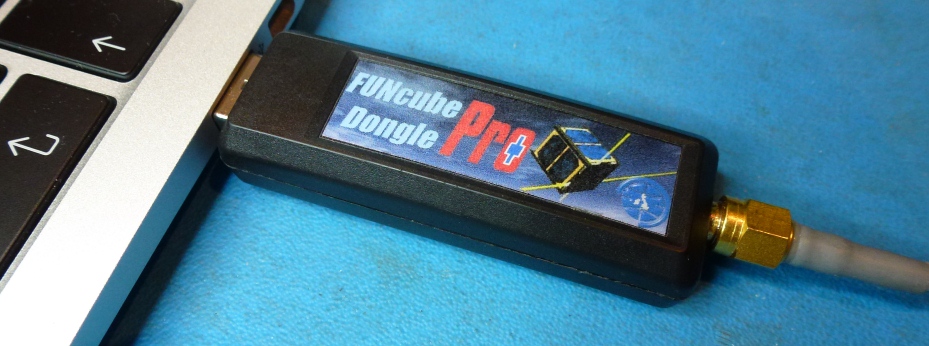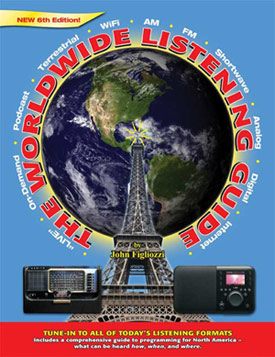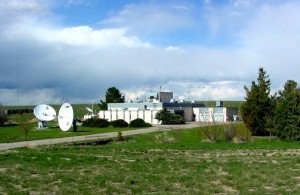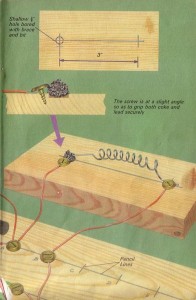I stumbled upon this WWII era book published by the Foreign Policy Association on Archive.org. A fascinating look at the the power and fear of propaganda over the shortwaves.
Category Archives: Books
2014 WRTH: A look inside
 I received my copy of the 2014 World Radio and TV Handbook (WRTH) directly from the publisher a few days ago, just prior to a 24 hour power outage.
I received my copy of the 2014 World Radio and TV Handbook (WRTH) directly from the publisher a few days ago, just prior to a 24 hour power outage.
As many SWLing Post readers know, I always look forward to receiving this staple radio reference guide each year. While other reference guides have dropped out of the scene, WRTH has remained strong, somehow resistant to the economy’s negative influence upon radio–and the publication’s quality has been wonderfully consistent. It’s no wonder that WRTH has a loyal readership–not only among hobbyists, but also among commercial broadcasters, thus giving it a much broader reader base.
WRTH’s team of noted DXers from around the world curate frequencies and broadcaster information by region; while I’m not sure how they orchestrate all of this, the end result is truly a symphony of radio information. In addition to broadcaster listings, WRTH’s radio reviews, feature articles, and annual HF report make for excellent reading.
But the WRTH isn’t just a frequency guide: the publication always devotes the first fifty or so pages to articles relating to the hobby. Following, I offer a quick overview of these.
The first article always features a WRTH contributor (indeed, it’s this very network of contributors that make WRTH and its listings such a success): this year, writer Max van Arnhem tells us how he got interested in the hobby and what being a contributor means to him.
 The second set of articles is always my favorite: WRTH receiver reviews. And the review in this issue is no exception. This year, WRTH reviewed the CommRadio CR-1 (which won their Best New Receiver award, and, I was pleased to see, received many of the same good marks I gave it). They also review the FunCube Dongle Pro+ (above), the new AOR AR6000, the WinRadio Excalibur Ultra (spoiler: the reviewers say it’s the best they’ve ever tested!), the AOR AR8200D handheld receiver, and the YouKits FG-01 Mk II Antenna Analyzer. As I’ve come to expect from this publication, these are all great comprehensive reviews.
The second set of articles is always my favorite: WRTH receiver reviews. And the review in this issue is no exception. This year, WRTH reviewed the CommRadio CR-1 (which won their Best New Receiver award, and, I was pleased to see, received many of the same good marks I gave it). They also review the FunCube Dongle Pro+ (above), the new AOR AR6000, the WinRadio Excalibur Ultra (spoiler: the reviewers say it’s the best they’ve ever tested!), the AOR AR8200D handheld receiver, and the YouKits FG-01 Mk II Antenna Analyzer. As I’ve come to expect from this publication, these are all great comprehensive reviews.
The following article is “The History of Shortwave Broadcasting in a Nutshell,” written by noted radio historian and author, Jerry Berg. In just a few pages, Berg takes you through the remarkable history of shortwave radio broadcasting.
Following this, noted DXer and WRTH contributor, Victor Goonetilleke, offers a fascinating article focusing on broadcasting on his home island country of Sri Lanka. It’s a enlightening overview of some of the changes that have occurred within the Sri Lankan broadcasting scene (DXers and SWLers will likely recognize many of the stations Goonetilleke mentions).
 WRTH always highlights a radio broadcaster as well, and this year, it’s the Voice of Vietnam. Despite my many years of hearing VoV on the air, I did not realize how deeply involved they were during the Vietnam War (which took place when I was a kid). The station today prides itself on responding to QSL requests and listener comments.
WRTH always highlights a radio broadcaster as well, and this year, it’s the Voice of Vietnam. Despite my many years of hearing VoV on the air, I did not realize how deeply involved they were during the Vietnam War (which took place when I was a kid). The station today prides itself on responding to QSL requests and listener comments.
The final sections of articles are dedicated to the WRTH digital update–this year’s subject is “Digital Future“–and their HF propagation report/forecast.
In summary, this is another great edition of the World Radio TV Handbook. As I’ve said many times, though I use online frequency databases fairly regularly, there is just no replacement for a good printed frequency guide. For DXers who collect QSL cards, you’ll find that broadcaster contact information in WRTH is often more up-to-date than a broadcaster’s own website.
Not only does WRTH contain more in-depth information on broadcasters and schedules, but it makes for quick reference, and doesn’t require a computer or Internet connection–much like, well, your shortwave radio.
Purchase your copy of WRTH 2014 directly from WRTH’s publishers, or from a distributor like Universal Radio (US) or Radio HF (Canada). Happy reading–and listening–in 2014!
The sixth edition of The Worldwide Listening Guide
 I’m very pleased to have just received the 6th edition of John Figliozzi’s Worldwide Listening Guide (WWLG). This is the latest updated version of the guide I reviewed last year.
I’m very pleased to have just received the 6th edition of John Figliozzi’s Worldwide Listening Guide (WWLG). This is the latest updated version of the guide I reviewed last year.
As I said then, you may want a copy of the WWLG in your shack–and, may I suggest, next to your computer or wi-fi radio.
SWLing Post readers know that I’m a huge fan of the Word Radio TV Handbook (WRTH)–it’s my go-to guide for radio frequencies–and Figliozzi’s Worldwide Listening Guide is my helpful companion for programming and for content.
Figliozzi exhaustively curates more than 4,000 programs, indexing their airing times, stations, days of broadcast, program types, frequencies, and web addresses. He also sorts the programs by genre: from arts, culture, and history; to music, sports, and more. In fact, he has a well-thought-out directory of at least forty genres–this directory has helped me locate programming about which I would otherwise have never known. Want to find jazz and blues programming, or shows focusing on sports? This book’s got you covered. Frankly, I’m not sure how Figliozzi manages to curate such a vast assortment of programming, but I’m happy he does, and that he offers it for our benefit!
Figliozzi even dedicates a section of his book to “The Big Six” English language broadcasters–namely, NPR, BBC, CBC, ABC, RTE and RNZ. These networks are widely regarded as the best in the business, with audience numbers to back this claim. The WWLG dedicates several pages to describing the structure and programming diversity of each, with listening tips and more.
I’ve always liked the WWLG, and it has become a permanent reference book in my shack, alongside my trusty WRTH. There is a surprising amount of information packed into this slim, spiral-bound book…enough to keep even a seasoned DXer contented for years.
The 6th edition of Worldwide Listening Guide can be purchased here:
Just arrived! The 2013 Pirate Radio Annual
Happiness is finding the new 2013 Pirate Radio Annual in your mailbox!
If you love pirate radio, or simply want to learn more about it, the Pirate Radio Annual is a must read!
Find out how to get your own Pirate Radio Annual by clicking here. I’ll try to post an overview in the coming weeks.
WRTH 2013 Summer (A) season available for download
 I just received the following message from Sean Gilbert with WRTH:
I just received the following message from Sean Gilbert with WRTH:
The WRTH editorial team are pleased to announce that the Summer (A) Season broadcast schedules file is now available to download for free from http://www.wrth.com/ just follow the link on the front page (updates).
Included in this file are: Broadcast schedules for international and clandestine/target broadcasters, international broadcasts in DRM, International frequency listing, and selected language broadcasts. Also included is a decode table for site and target area codes.
The 80 page file is just over 2MB in size and in PDF format (with bookmarks to assist in navigating between sections) and unique section page numbering to assist with printing. You will need the free Adobe Acrobat reader in order to open this file. The Acrobat Reader can be downloaded from http://www.adobe.com/
We hope you find this file a useful accompaniment to the printed WRTH.
History of WWV and the NIST Time Stations
Many readers know that I’m a bit of a WWV geek, so you can imagine how happy I was when my buddy, Mike, and the Southgate ARC made me aware of this 152 page history of the NIST time station family. At first glance, this looks to be an authoritative and thorough history indeed.
I have already sent this to my Kindle Fire and look forward to reading it (at least, starting it) tonight. Click here to download the NIST time station history as a PDF.
Incidentally, if you have an affinity for the NIST time stations, be sure to check out my previous post on Myke’s audio history of WWV, “At The Tone.”
Making A Transistor Radio by George Dobbs
Those of you who are ham radio operators (especially QRPers) are familiar with the name George Dobbs (G3RJV). In 1972, Reverend Dobbs wrote a book called, Making A Transistor Radio and now it’s available online.
Making A Transistor Radio is a clear, simple, step-by-step guide to building your own transistor radio. In each stage of the process you’re rewarded with a working radio. In addition, you’ll learn about all of the stages of a working receiver.
Perhaps what I love best about this book–besides the fact that is resembles the mountains of electronics books I poured through in my youth–are the illustrations. Each illustration describes exactly how each component of the radio should be built, leaving nothing to be pondered.
If you’ve ever wanted to build your own radio, from scratch, this is a great place to start.
Thanks, Eric, for sending this link!




